Developing an Experimental Joint Airborne Division for Hybrid Warfare and Great Power Competition
By Justin Baumann
Disclaimer: The views expressed in this article are solely those of a civilian author and do not reflect any official policy or position of the Department of Defense or any U.S. Government Agency.
Abstract
This article details the advantages the US military can gain by developing an experimental joint airborne division for use in current or future hybrid conflicts while simultaneously countering emerging proxy threats during Great Power Competition. It highlights the current capability gap in our airborne formations between conventional and irregular airborne units and provides a plan to address this issue with the creation of an experimental joint airborne division led by the Army and staffed by additional joint personnel. This article loosely follows the Doctrine, Organization, Training, Material, Leadership, Personnel, and Facilities (DOTMLPF) planning tool used by joint planners to illustrate the advantages a unit like this would provide to our Geographic Combatant Commanders (GCCs). It provides a framework to construct an experimental joint airborne division from the ground up while attempting to anticipate and overcome any potential challenges which would hinder its successful fielding and operational deployment within Joint All-Domain Operations (JADOs).
Keywords
Hybrid Warfare, Airborne Operations, Large Scale Combat Operations (LSCOs), Joint All-Domain Operations (JADO), Multi-Domain Operations (MDOs), Maneuver Warfare, Vertical Take-Off and Landing (VTOL), Great Power Competition, Combined Arms, Maneuver Warfare, United States Army, United States Marine Corps, United States Air Force, Operation Junction City, Special Operations, Green Berets, Rangers, Joint Special Operations Command (JSOC), Geographic Combatant Commanders (GCCs), Army Special Operations (ARSOF), Marine Corps Special Operations Command (MARSOC), Special Operations Command (SOCOM), Army Special Operations Command (ARSOC), Infantry, Irregular Warfare (IW).
Introduction
“Experimentation has played a major role in the transformation of military forces throughout history. The process of experimentation with new military capabilities and force structures is not just a matter for simulations in laboratories or for the writings of theorists. Its success often depends on the establishment of experimental units that can test emerging theoretical and technological capabilities to the fullest. Moreover, it is not just a matter of peacetime innovation. The historical record indicates that experimental units in wartime can be equally important in developing new possibilities and potential.” [1] As Williamson Murray explains in Experimental Units: The Historical Record, “Confronted with a dynamic environment in which technological and tactical change was the order of the day, some military institutions have used experimental units not only to point the way to the future but as a means to further the doctrinal and conceptual possibilities. In preparing for warfighting in this century, America’s military leaders must remember what history has demonstrated in the pursuit of new weapons systems and revolutionary new ways to fight:
- The capabilities and limitations of radically new weapons systems can best be discovered through the creation of experimental units.
- The military should use lessons-learned analyses to challenge current concepts and beliefs, and not to justify them or to make their officers look good.
- Feedback loops should be used to empower and build on experimental units, and help build a more accurate picture of the battlefield.
- Experimental units should remain connected to an intelligent basic doctrine capable of expansion and flexibility.
- Concepts and tactical framework of the experimental forces should be tested to their limits. When the results show that the experimental units are not working out, they should be changed.
- To challenge the traditions and culture of a military service still requires the services of mavericks, usually seen as the outsiders.” [2]
As modern military units evolve, the United States military should remain on the front line of experimenting with new units to counter the various types of potential threats we might see on the hybrid warfare proxy battlefields that could emerge during Great Power Competition. Hybrid conflicts are a mixture of conventional and irregular factions competing for power. In the last 50 years, the United States has faced off against a myriad of these insurgent, terrorist, and non-state actors across global battlefields. These combat lessons have shown us that there are gaps in our joint offensive and defensive airborne capabilities for Geographic Combatant Commanders to properly deploy in hybrid conflicts. [3] [4] The following section describes how this capability gap in our airborne operations has emerged and how the fielding of an experimental unit like the one presented here can bridge that gap.
Bridging the Gap
Currently, the United States military possesses a formidable arsenal of airborne ready units, many of which have years of combat experience from the recent wars in the Middle East. However, American airborne units have been developed on opposite ends of the spectrum of hybrid warfare. Large conventional airborne units like the 101st and 82nd Airborne Divisions came of age during World War II as a means of delivering conventional military formations across the European continent and bypassing enemy defensive obstacles. [5] On the other side of the spectrum, the recent wars in the Middle East have increased the focus on small unit, irregular warfare airborne operations under the auspices of an expanded Special Operations Command (SOCOM). Units like the 75th Ranger Regiment, US Army Special Forces, Navy SEALs, and Marine Raiders, saw their prestige and use rise as an effect of heavy operational activity during the Global War on Terror [6]. The last 20 or so years have been a Golden Age of special operations development. But while these units are all airborne qualified, the number of actual combat jumps since 9/11 has remained somewhat low. [7]
As the US military has focused on the extreme ends of the spectrum, however, a gap has emerged between the two. This gap exists because current units have been trained and fielded with those extremes in mind. While US military forces are extremely adept at large-scale conventional warfare airborne operations, and small-scale irregular warfare airborne operations, we do not currently possess a unit which can execute small-scale conventional warfare airborne operations, or (relatively speaking) large-scale, in frequency or size, irregular warfare airborne operations. The following US Military Airborne Capabilities Matrix diagram illustrates this concept:
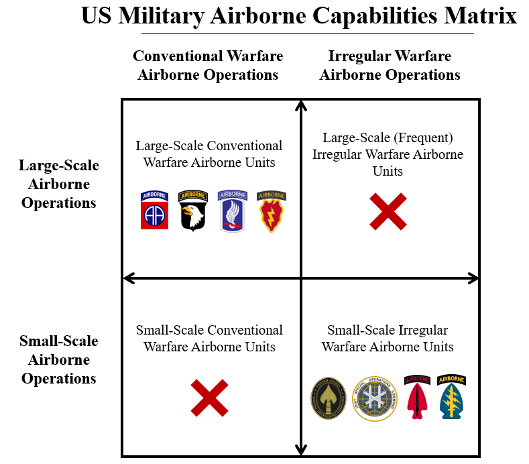
Past Hybrid Warfare Usage
In 1967, during the Vietnam War, a large-scale airborne operation took place involving the 173rd Airborne Brigade Combat Team in Operation Junction City against hybrid, conventional, and irregular warfare units of North Vietnam. In 1983, members of the Command and General Staff College (CGSC) and the Junction City Battle Study Group, which included then Captain, now General David Petraeus (Retired), studied the battle and concluded that “The multiple assaults on the periphery of the horseshoe achieved tactical surprise on the ground. However, by the end of D-day, the shape and purpose of the cordon must have become clear to the Viet Cong in the area. Thus, these elements were permitted a 12-36 hour period to infiltrate through the cordon to sanctuaries in Cambodia or perhaps more accurately to disperse and disappear into underground fortifications and installations.” [8]
This excerpt reinforces the idea that current conventional units are too large to execute the types of mission sets proposed here because their tactical deployment size makes them too slow to respond to smaller, more frequent engagements. The logistics of moving several hundred airborne and airmobile soldiers was enormous. It “was the largest single day helicopter operation in the history of army aviation to date and also included a record number of Air Force sorties flown in a single day—575.” [9] In this historical example, the unit’s operational footprint lends itself to seizing and holding terrain, but what if that is not always the goal? How can the joint forces use large-scale, pinpoint airborne operations in irregular warfare conflicts to eliminate and neutralize insurgent forces quickly in response to frequent enemy contact? I believe the answer lies not with current airborne doctrine and unit formations, but with a joint, close combat airborne division, staffed by Army, Marine Corps, and Air Force personnel. During Operation Junction City, the US enjoyed approximately a 13 to 1 kill-to-death ratio sourced from the above-mentioned report. However, with a much smaller force using the type of innovative tactics described here, the Rhodesian Fire Force, which will be described in more detail later, enjoyed an 80-1 kill-to-death ratio over the course of the Rhodesian Bush War in the 1960’s and 1970’s. From these past operations, I believe that using large-scale conventional warfare airborne formations in irregular warfare combat operations is not ideal and a waste of their skills and training. [10]
Doctrine, Tactics, & Organization
In the mid 1960’s to late 1970’s, the former British colony of Rhodesia experienced a civil war which forced them to develop a new type of close combat airborne unit, the Fire Force, and this unit experienced incredible success against communist insurgent rebels. This is an excellent summation of their tactical operations: [11]
“By the 1970's, the Rhodesian Security Forces were facing a growing and determined insurgency in the civil war known as the "Rhodesian Bush War." Faced with increased threats, manpower and equipment shortages, and a large territory to cover, they needed a new tactic to deal effectively with rebel groups. This led the Rhodesian Light Infantry to the development of the Fire Force, a vertical envelopment technique involving light infantry, helicopters, and paratroopers in a rapidly deployable posture. A Fire Force was equipped with four helicopters, one C-47 Dakota transport aircraft, and a light attack aircraft. The helicopters were of two types; the K-Car and the G-Car. The K-Car was so called because it was the 'killer' with its 20mm cannon and functioned as the command and control aircraft. The G-Cars served as gunships with machine guns and as transports for heliborne troops, though they were only capable of carrying four combat loaded troops at a time. The unit was also supported by vehicles, called the 'Landtail' that supported the deployment of the airborne component. Weapons were standard for Africa at the time – FN FALs and FN MAG machine guns. A unit set to a fireforce mission was distinctly organized from standard infantry units. Instead of fire teams, squads, and platoons, the Fire Force was composed of ‘waves’ that were broken down into stops, also known as sticks, each consisting of four men, due to the space constraints on the G-Cars. Each stop had a stick leader, machine gunner, and two riflemen, one of which was also trained as a medic. The fireforce airborne component was composed of eight stops. Stops one through three were assigned to the G-Cars while stops four through eight were assigned as paratroopers. These forces, along with the light attack aircraft, constituted the first wave. The remaining men assigned to the fireforce were in vehicles as the ‘Landtail,’ or second wave. There were three main Fire Force units located at three bases throughout the country, ready to respond to a contact or sighting of enemy forces by the Selous Scouts. That's when the excitement began. Once contact was reported, a siren would sound alerting the Fire Force. The first three stops [squads] would board helicopters while the rest would quickly don parachutes with the help of off-duty team members. The airborne component would rush to the objective where the Fire Force commander would determine a drop zone and position the heliborne stops to encircle the rebels. Once on the ground, the stops would attempt to stop the enemy. They would act as blocking positions for the sweep element, usually paratroopers, creating the classic hammer and anvil movement. Combined with circling gunships and close-air support, this method proved deadly effective, resulting in a kill ratio of better than 80:1.” [12]
“The K-Car was also used as a mobile command post to allow the commander of the heli-borne troops to direct their operations from the air above them. Thus, radio equipment and a specially adapted rearward-facing chair next to the pilot’s [sic] were provided. The army Fire Force commander was in overall charge but the K-Car pilot, usually the most senior pilot in the unit, would direct the air operations. Their roles being equally important for success but in many cases the experienced pilots would dominate and sometimes control the entire operation. The pilot’s defined responsibilities were: to transport the Fire Force troops to the target; to mark the target (with the gunner throwing out the smoke grenade); to direct the landing of the troop-carrying helicopters (the G-Cars) and the dropping of paratroops where the Fire Force commander indicated (sometimes delegating the talk-in of the Dakota to the first immediately available G-Car); to bring in and direct airstrikes; to send aircraft away for reinforcements and refuelling; and to control the recovery of troops, equipment and dead and captured enemy.” [13]
“The Fire Force was used most successfully in tandem with information on insurgent locations obtained from static observation posts, Selous Scouts “pseudo-operations,” and other ground intelligence sources. As an immediate reaction force, it could be also scrambled whenever any ground forces required support. This was a great morale builder for the average soldier, who knew that assistance was only 30 minutes away at the most. Demands on the Fire Force continued to increase during the closing years of the conflict, to the point where it was not unusual for it to be deployed as often as three times a day in certain heavily contested areas.” [14]
The tactical advantages evidenced here leverage fast moving air platforms to provide not just troop delivery methods, but also additional firepower and Air-To-Ground (AGI) enablers. This combination of air and ground assets into one deployable unit package will result in greater tactical proficiency over attempts to cobble separate air and ground units together in unpredictable future hybrid, conventional, or irregular conflicts.
Can current units provide these capabilities?
Bottom line up front: No. The Mission Essential Task List (METL) can only be so long. Many Green Berets and Rangers will say that this type of mission is ideally suited to what they already do. But Green Berets are well-trained for many irregular warfare specific tasks not needed by this unit like foreign internal defense, information operations, counterproliferation of weapons of mass destruction, language training, and security force assistance, among many others. Army Rangers are trained in many conventional tasks to assist Army Special Operations Forces (ARSOF) and removing them from their current role would create gaps for those special operations units that we cannot afford to lose. The experimental unit presented here should be fielded as a conventional warfare unit, and Green Berets and Rangers are trained in other highly specialized irregular warfare missions and tasks that are integral to our national defense. There is crossover, but this is a built-in redundancy for mission readiness, not an obstacle to implementation. [15] This separation also prevents additional operational strain on the 160th Special Operations Aviation Regiment (SOAR).
Other current US military special operations units like the Navy SEALs and Marine Raiders have very specialized training that makes them ill-suited for the specific mission tasks being proposed here. Their units form a wide breadth of specialized skills required to achieve Full-Spectrum Dominance that the US military should retain. However, because they are very specialized, this creates problems when commanders and doctrine believe they are equipped and trained to complete any tactical mission task assigned. By relying on specialized units to complete any type of broad direct-action mission or task, US military planners have become dependent upon SOF capabilities to cover conventional units’ capability shortcomings and gaps; an issue this proposed unit seeks to address.
A final argument is that we can use an air-mobile unit like the 101st Airborne Division (Air Assault) or the 82nd Airborne Division for these types of missions. Unfortunately, these units suffer from the same large-scale airborne logistics issues experienced in Vietnam as well as other hybrid conflicts with mass conventional airborne operations. Their training and operational missions are a specific capability the US military should retain, but if we want to advance new TTPs and gain unique airborne hybrid warfare operational experience, we will best accomplish this through the creation of an entirely new joint airborne division like the one described here.
Proposed Unit Task Organization
General George Patton is quoted as saying, “There is still a tendency in each separate unit…to be a one-handed puncher. By that I mean the rifleman wants to shoot, the tanker to charge, the artilleryman to fire …. That is not the way to win battles. If the band played a piece first with the piccolo, then with the brass horn, then with the clarinet, and then with the trumpet there would be a hell of a lot of noise but no music. To get harmony in music each instrument must support the others. To get harmony in battle, each weapon must support the other. Team play wins. You musicians …. must come into the concert at the proper place and at the proper time.” [16]
This quote forms the principle behind this article: If we have a new instrument, we should integrate it properly into the orchestra. This suggested unit seeks to adhere to this principle by introducing a new capability for ground commanders. For branch, training, staffing, and doctrine, it should be an infantry branch-based organization with recruits drawn from Army infantry 11-series Military Occupational Specialties (MOSs) and Marine Corps infantry 0300-series MOSs. This allows airborne qualified enlisted and officer personnel to move between this unit and other airborne qualified units. This would be beneficial for the Army and Marine Corps as natural airborne Tactics, Techniques, and Procedures (TTPs) would move their way from these units back through jumpmasters to other airborne units. This knowledge sharing feature has been seen in historical experimental units as well. [17] The following proposed task organization comprises a rough approximation of how these “shocktrooper” units could be organized for maximum effectiveness. War gaming and real-world operations would ultimately expand our knowledge of this concept further than what is depicted here:
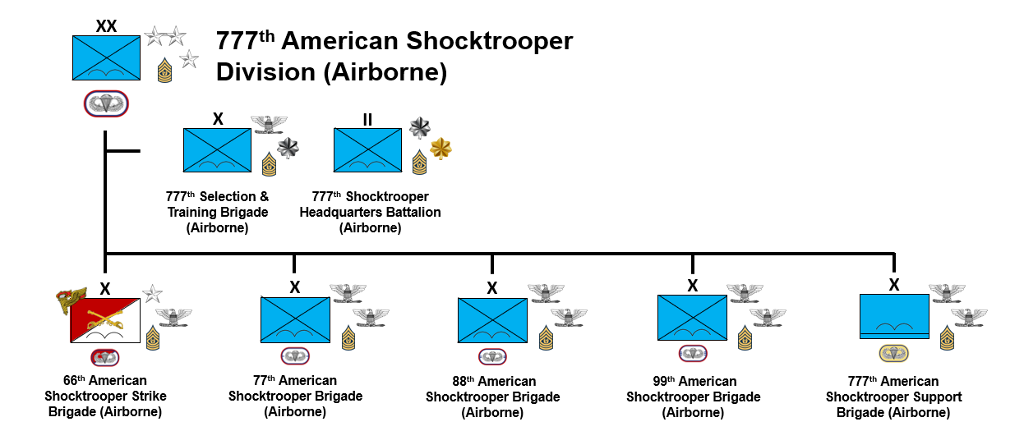
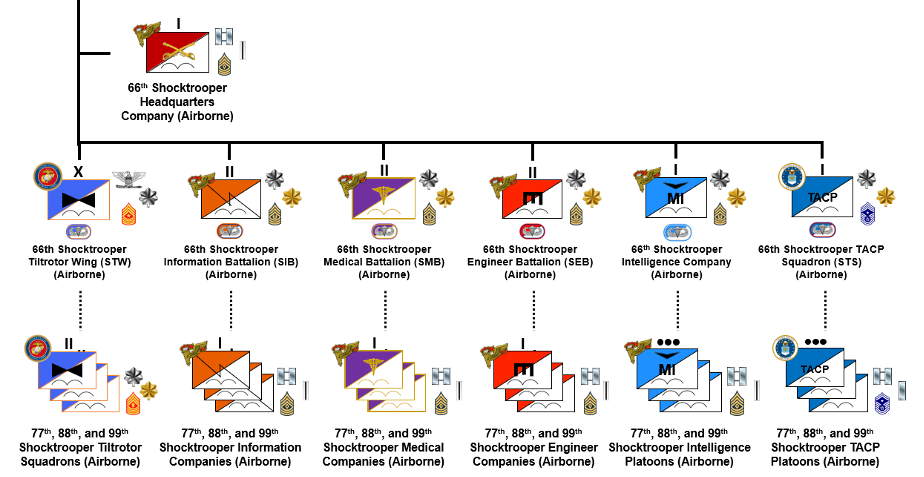
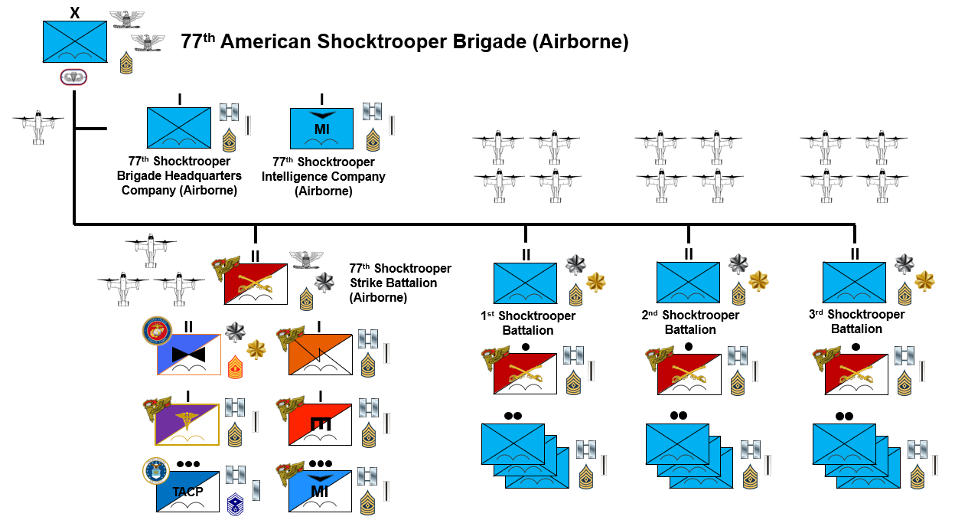
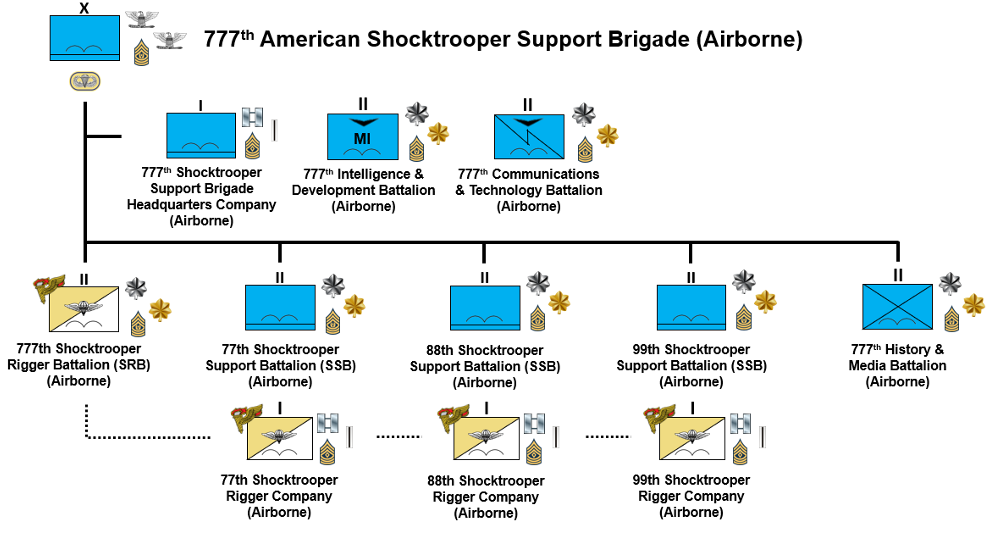
Training for the Unknown
The theme of the 2019 Maneuver Warfighter Conference was “readying the Brigade Combat Team for Large Scale Combat Operations (LSCO).” [18] In order to ready our forces to properly address threats in LSCOs, as explained in FM 3-0, we must be at the forefront of developing new units to counter unforeseen threats. LSCOs can appear and disappear quickly. The build-up of these operations can take months, but the actual direct action engagement time can be much quicker. [19] Because of this, commanders in LSCOs must have the correct tools to respond quickly to the chaotic shifting of combat scenarios. A close combat shocktrooper unit is a must if we want to properly prepare our forces for LSCOs. As a conventional unit, this division would also be able to assist in humanitarian evacuations with the use of its aircraft. Skeleton crews can provide defensive protection while the aircraft are loaded. This type of additional capability provided by a unit like this shows the multi-purpose nature and benefits to GCCs.
General (Retired) David Perkins said it well in a 2015 speech to the U.S. Naval War College as then TRADOC Commander when he said, “What we’re saying the future we’re going into, we don’t know who we’re going to fight, we don’t know what the coalition is, we don’t know what the ROE- uh, rules of engagement will be, we don’t even know what weapon system the enemy is going to have […] and that’s a completely different kind of world. So I tell folks look, I only need to know: do you want me to design an Army to deal with a known problem or an unknown problem? That’s all the level of clarity I need cus’ those are two different kinds of Armies. If you are building an Army to deal with a known problem, with a known enemy in a known part of the world, known coalition, you train people differently, you develop people differently, you buy different kinds of material and you buy things differently. Very different. If you say: I want to build an Army for the unknown, you train people completely different, you develop them differently, you buy different stuff, and you buy stuff differently […] from my point of view that’s the only amount of clarity I need: Do you want an Army to deal with a known problem or an unknown problem? Two different kind of Armies.” [20] The unit presented here allows the US military to increase combat power at the fulcrum between conventional and irregular airborne warfare, while giving future commanders the ability to shift between the two depending on the conflict characteristics.
Airframes
Since the introduction and operational deployment of the V-22 Osprey, Vertical Take-Off and Landing (VTOL) has provided an additional airlift capability for the US military. This capability, combined with close combat airborne unit tactics, can enable a new type of modern Fire Force unit as the V-22 can simultaneously function as the “G-Car”, dropping off units, then, using its VTOL capability, can switch to the “K-Car” as a mobile aerial gun platform with heavy onboard machine guns. Although there have been issues arming V22s in the past, future VTOL airframes could reduce or eliminate this issue entirely. Thus, the V-22 allows modern Army units to combine the K and G-car concepts into one platform, facilitating shared resources and leveraging multi-faceted combat functions like personnel delivery, communication hubs, fire support duties, and tactical overwatch into one airlift capability, rather than relying on other fixed and rotary wing aircraft like the Rhodesians. This G-Car/K-Car combination will better enable a 3:1 firepower ratio in the shocktroopers’ favor even if they are outnumbered on the ground. [21]
Because the Marine Corps operates the largest number of V-22s, and they provide an additional pool to draw recruits from, the V-22 Shocktrooper Tiltrotor Wing (STW) can be provided by existing or additional Marine Corps units. Marines would undergo the same training as US Army personnel and must go through shocktrooper selection and training, creating a joint operational unit. Through the Marine Corps Tiltrotor Wing and Air Force TACP Squadron, additional staffing opportunities for Navy and Coast Guard personnel would exist making the Shocktroopers a joint division staffed by different defense services led by the Army. This continuous rotation by other branches in and out of this unit would further much greater service-wide knowledge dissemination of airborne employment and experiences.
“The Rhodesian Intelligence Corps study in 1979 concluded that the most successful combination was a K-Car, four G-Cars (each carrying four troopers) reinforced by a Dakota (modified for paratrooping and carrying 16 paratroops) and a Lynx for light air strike (with 63mm SNEB rockets, mini-Golf bombs [blast and shrapnel], napalm, and twin .303 inch machine-guns mounted above the wing). As contact was made typically with 6 to 12 ZANLA, this force level of 32 gave the Fire Force a three to one ratio of superiority on the ground. The Fire Force quickly yielded an 80 to 1 kill rate by trapping the enemy gangs and eliminating them by air and ground fire.” [22] As an experimental unit, many different multipliers can be tested to provide the unit with a good idea of what works best. This would allow testing of close combat airframes like the A-29 and others for close air support.
Strike Brigade
The Strike Brigade, and its battalions, would be organized as light airborne infantry reconnaissance, able to adapt to the mission as the commander sees fit. The Strike Brigade, while not conceived from, does share many similarities to the way velites functioned during the early years of the Roman Army’s tactical development and evolution. “When the legion advanced, the velites retired through the intervals, part falling back behind the triarii, and the rest sustaining the hastate and principes, furnishing them with darts and spears, and carrying the wounded to the rear.” [23] These duel MOS personnel can provide quick insertion or offensive or defensive packages by the commander, providing much needed force multipliers at the commander’s request and within planning cycles. Most of these units would be dual trained in their primary MOS (Medical, Engineer, Intelligence, etc.), while also being trained in light airborne reconnaissance operations (Pathfinder, Casualty Evacuation, Etc.). [24] [25]
Selection
Candidates who successfully pass a 30-day selection course would be allowed to begin courses in the shocktrooper training pipeline to conclude with being awarded the shocktrooper beret and tab. Many of these courses would be designed to be in house as well as sharing schools for basic skills related to airborne operations: Airborne School, Jumpmaster, etc. Because the Army has recently announced they will be ending Pathfinder School, reopening Pathfinder School under this unit can prevent atrophy of those hard-earned skills and these lessons can be incorporated into shocktrooper operations and future advanced airborne operations and training [26].
As the US Army has quietly phased out the black beret, there emerges an opportunity here to honor the past legacy of Rangers who wore the black beret and provide an incentive for shocktrooper recruitment. There are also larger psychological benefits related to its threat perception on the battlefield for enemies. Colored berets for units should be earned, not given. A black beret and black tab conferred at “Shocktrooper Qualification Course” (SQC) graduation helps convey the importance and dangerous nature of the mission to those willing to join. Additionally, this helps eliminate a brain drain of conventional officers and NCOs moving to irregular units which are perceived as being more elite than their conventional counterparts, thus drawing a skewed number of talented soldiers away from conventional warfare forces.
This suggested patch design combines both the U.S. Army Infantry school “Follow Me” and Marine Raider patches to enshrine the deep historical roots the Army and Marine Corps share fighting on battlefields around the world. This signifies the joint nature of the unit and would help provide a distinctive source of pride for its members.
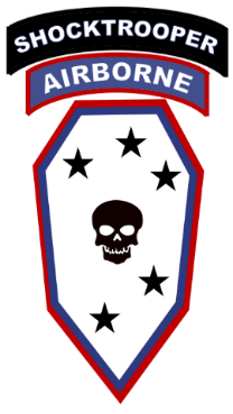
Potential Locations
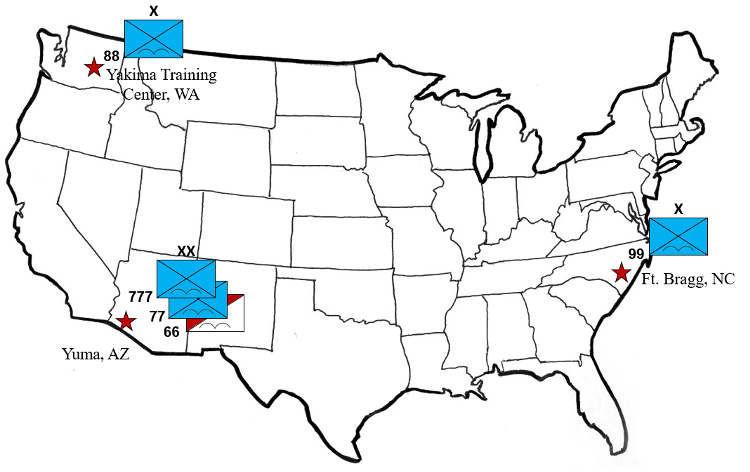
Conclusion
This unit proposition gives senior US military leaders the option to test a low-risk, high-payoff experimental unit which could result in incredible benefits to American ground commanders in LSCOs, JADOs, or other combat operations for the foreseeable future. The lessons gained by developing this unit could see military advancements into the next 25-50 years regarding airborne operations and tactics development. This plan is meant to be a lasting enterprise for the American military. As VTOL aircraft technology develops further into the future, a unit like this can capture lessons learned and further develop doctrine and tactics to improve our operational art on the hybrid warfare battlefield. This will provide our commanders the tools necessary to be successful during hybrid conflicts or Great Power Competition proxy wars. [27] Is this a solution looking for a problem? Absolutely. Forward-looking ideas are anticipating future problems based on current knowledge and issues and designing solutions for them now. That is how we will fight and win our nation’s current and future wars. As General Richard Clarke, the SOCOM Commander said in November 2019, “Veterans come with a wide range of technical skills, but most share this critical talent: the ability to see problems, define those problems, and build teams that solve those problems.” [28]
Biographical Information
Justin Baumann is from the Pacific Northwest where he first became interested in smokejumpers and airborne operations. He has completed graduate degrees from the University of Southern California and Arizona State University in public and business administration. He served with the 1st Battalion, 4th Infantry Regiment (OPFOR) in Afghanistan and the 82nd Airborne Division in Iraq before getting out of the Army. Special Thanks to Mitch, Dan, Robert, Stu, Greg, and Zack for their feedback. Airborne!
Endnotes
[1] Gold, Ted. Foreword. Murray, Williamson, Experimental Units: The Historical Record. Institute for Defense Analyses. May 2002. Accessed November 2020. https://apps.dtic.mil/dtic/tr/fulltext/u2/a412051.pdf
[2] Murray, Williamson. Experimental Units: The Historical Record. Institute for Defense Analyses. May 2002. Accessed November 2020. p. 21.
https://apps.dtic.mil/dtic/tr/fulltext/u2/a412051.pdf
[3] The Taliban still exists for example.
[4] Hoffman, Frank G. Conflict in the 21st Century: The Rise of Hybrid Wars. Potomac Institute for Policy Studies. December 2007. Accessed November 2020. https://www.potomacinstitute.org/images/stories/publications/potomac_hybridwar_0108.pdf
[5] Major Martinez, Christopher. Operation Market Garden and Modern Airborne Insertion: The Strategic Cost of Airborne Operations. US Army Command and General Staff College, School of Advanced Military Studies. 2018. Accessed November 2020. http://cgsc.contentdm.oclc.org/cdm/singleitem/collection/p4013coll3/id/3753/rec/149
[6] Campion, John J. Calculated audacity: case studies of special operations during large scale combat operations. Fort Leavenworth, KS: US Army Command and General Staff College. June 2019. Accessed November 2020. https://cgsc.contentdm.oclc.org/digital/collection/p4013coll2/id/3840 p. 1
[7] Milzarski, Eric. These are the only combat jumps US troops have made since 9/11. We Are the Mighty. April 2020. Accessed November 2020. https://www.wearethemighty.com/history/post-911-combat-airborne-jumps
[8] Junction City Battle Study Group. Operation Junction City Vietnam 1967. U.S. Army Command and General Staff College. 1983. Accessed November 2020. p. 1 https://apps.dtic.mil/dtic/tr/fulltext/u2/a139612.pdf
[9] “By the end of the operation, army aviation had flown over 80,000 sorties and airlifted 19,000 tons of resupply”
Ibid. p.13 https://apps.dtic.mil/dtic/tr/fulltext/u2/a139612.pdf
[10] “In search and destroy patrols, the role of the infantry and artillery was usually reversed. For the infantry would find and fix the enemy while calling in artillery and close air support to destroy and defeat the enemy.”
Ibid. p. 14 https://apps.dtic.mil/dtic/tr/fulltext/u2/a139612.pdf
[11] Another Historian Wargamer. The Rhodesian Bush War 1965-79: Fireforce. July 24, 2019. Accessed November 2020. https://www.youtube.com/watch?v=wGeP-yTt0ns
[12] Elphick, James. The Rhodesian Fireforce took airborne operations to a whole new level. We are the Mighty. April 2018. Accessed November 2020.
[13] Dr. Wood, J.R.T. Fire Force: Helicopter Warfare in Rhodesia: 1962-1980. 1996. Accessed November 2020. http://www.jrtwood.com/article_fireforce.asp
[14] Dozer, T.A.L. Selous Scouts. 2007. Accessed November 2020. http://selousscouts.tripod.com/
[15] Additional crossover tasks are unconventional warfare, direct-action, counter-insurgency, and special reconnaissance, but these are up to the conventional ground commander, not an additional unit operating in their battlespace. By this method, shocktroopers would possess several conventional and unconventional crossover skills and tasks which would help bridge any gaps in our hybrid-warfare threat defeat mechanism arsenal. One notable example for training is that Green Berets undergo approximately 6 months of language training. This type of training is not needed for shocktroopers and that time could be spent on other more relevant onboarding training courses for shocktroopers.
[16] Combined Arms Training Activity. The Musicians of Mars: A Story of Synchronization for the Company/Team Commander. Center for Army Lessons Learned. June 1990. p. 3. Accessed November 2020. https://usacac.army.mil/sites/default/files/publications/90-6MoM.pdf
[17] “Leading the counterattack were Stormtroopers, a recent innovation that emerged from the raiding units organized originally to handle the exigencies of trench warfare. The Stormtroopers were equipped with new and more effective weapons, but more importantly their training, doctrine, and leadership differed substantially from regular line infantry units. The Stormtroop units brought new concepts of combined-arms fire and maneuver to a battlefield once characterized by tactical futility. In addition, they eventually served as instructors to the regular infantry formations with which they served.”
Murray, Williamson. Experimental Units: The Historical Record. Institute for Defense Analyses. May 2002. Accessed November 2020. p. ES-1. https://apps.dtic.mil/dtic/tr/fulltext/u2/a412051.pdf
[18] Brigadier General Hodne, David. Readying for LSCO: Building on the Fundamentals. Infantry Magazine. Summer 2019. Accessed November 2020. p. 1 https://www.benning.army.mil/Infantry/Magazine/issues/2019/Summer/PDF/1_CommNote.pdf
[19] Pagonis William G. and Krause, Michael D. Operational Logistics and the Gulf War. The Land Warfare Papers. October 1992. Accessed November 2020.
https://www.ausa.org/sites/default/files/LWP-13-Operational-Logistics-and-the-Gulf-War.pdf
[20] General Perkins, David G. (2015) Lecture of Opportunity: The Army Operating Concept. U.S. Naval War College. YouTube 18:20. November 2015. Accessed November 2020. https://www.youtube.com/watch?v=cejIOH-yjIE
[21] Boeing. V-22 Osprey: Unlike any aircraft in the world. Accessed November 2020. https://www.boeing.com/defense/v-22-osprey/
[22] Dr. Wood, J.R.T. Fire Force: Helicopter Warfare in Rhodesia: 1962-1980. 1996. Accessed November 2020.
http://www.jrtwood.com/articles.asp (Click on the Fire Force Article Page)
[23] Dodge, Theodore Ayrault. Great Captains: Hannibal. 1891. Da Capo Press, 2004. p. 55
[24] Maj. King, Kenneth T. Electronic warfare and organizational encopresis: the neglect of the US Army and its Intelligence Branch to advocate for warfighting capabilities in the electromagnetic spectrum. US Army Command and General Staff College. School of Advanced Military Studies. 2019. Accessed November 2020. http://cgsc.contentdm.oclc.org/cdm/singleitem/collection/p4013coll3/id/3883/rec/1
[25] Maj. Spring-Glace, Morgan J. Return of Ground-Based Electronic Warfare Platforms and Force Structure. Military Review. July-August 2019. Accessed November 2020. https://www.armyupress.army.mil/Journals/Military-Review/English-Edition-Archives/July-August-2019/Spring-Glace-Electronic-Warfare/
[26] Rempfer, Kyle. Pathfinder School at Fort Benning slated to officially get the ax. Army Times. November 12th, 2020. Accessed November 2020. https://www.armytimes.com/news/your-army/2020/11/12/pathfinder-school-at-fort-benning-slated-to-officially-get-the-axe/
[27] “The missteps committed by the IDF in this war [2006 Lebanon War] provide the US Army with valuable examples of potential difficulties when counterinsurgency operations are abruptly changed to major combat operations. For the US Army, which has been almost exclusively involved in irregular warfare for years, this issue is of paramount importance. While the US Army must be proficient in conducting major combat operations around the world, it is possible that years of irregular operations have chipped away at this capability, not unlike the situation encountered by the IDF.”
Matthews, Matt. We Were Caught Unprepared: The 2006 Hezbollah-Israeli War. Ft. Leavenworth, KS. Combat Studies Institute Press. Accessed November 2020. p. 65 https://www.armyupress.army.mil/Portals/7/combat-studies-institute/csi-books/we-were-caught-unprepared.pdf
[28] General Clarke, Richard. Quoted in USSOCOM Tweet. Accessed November 2020. https://twitter.com/USSOCOM/status/1195853010641072128
About the Author(s)
Comments
We are committed to…
We are committed to providing our clients with exceptional solutions while offering web design and development services, graphic design services, organic SEO services, social media services, digital marketing services, server management services and Graphic Design Company in USA.
Interesting, but utter…
Interesting, but utter nonsense. A solution without a problem. It appears SWJ is thirsty for content...
